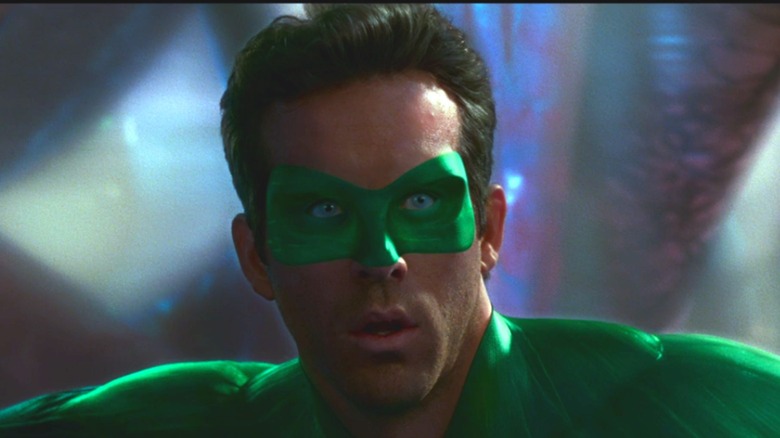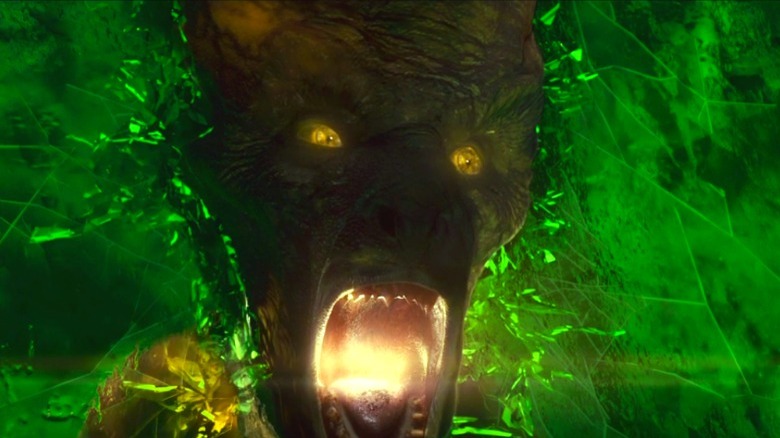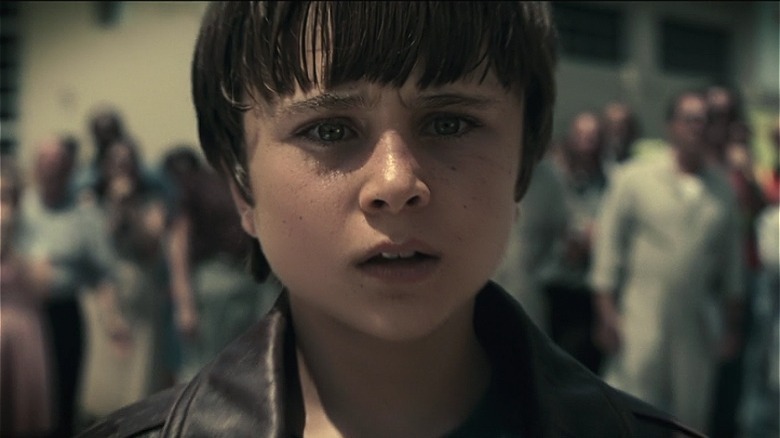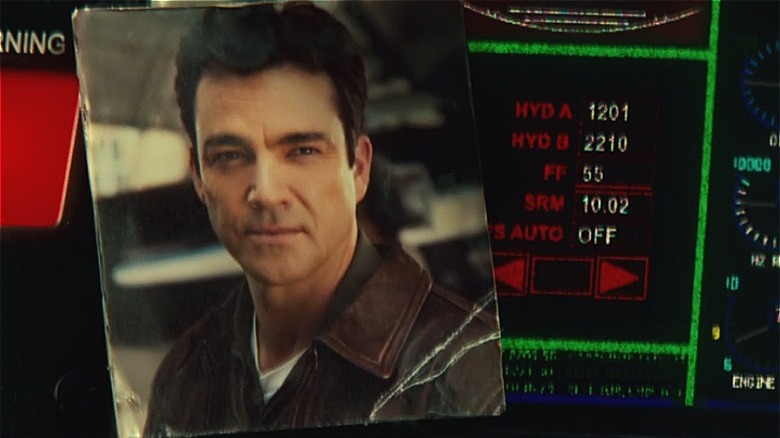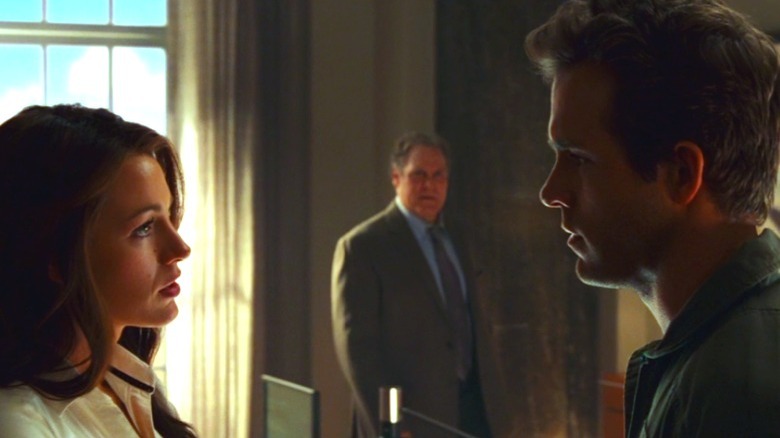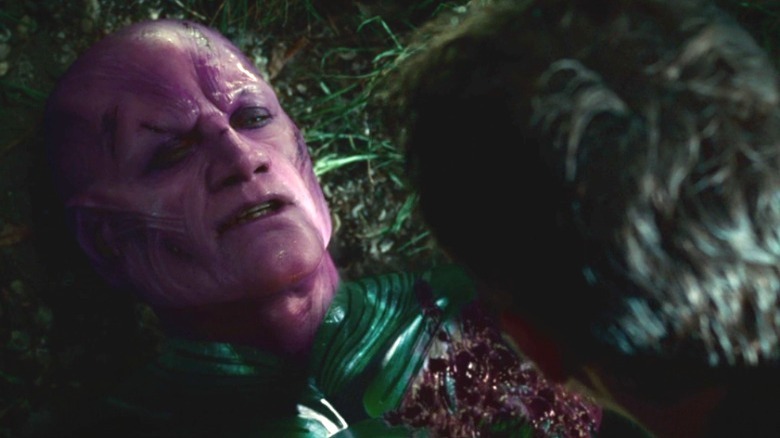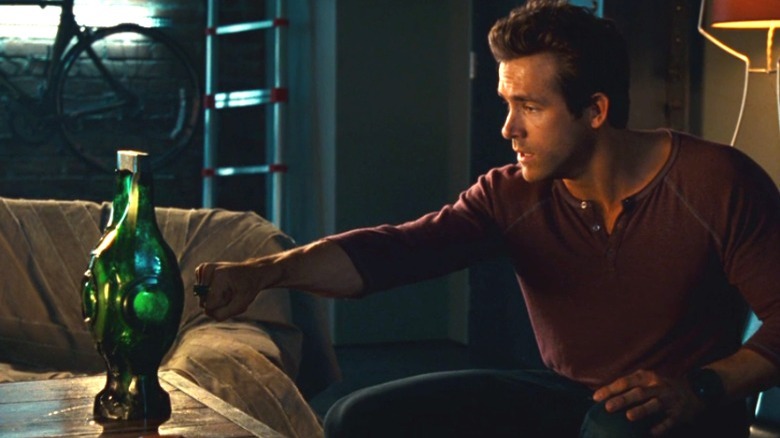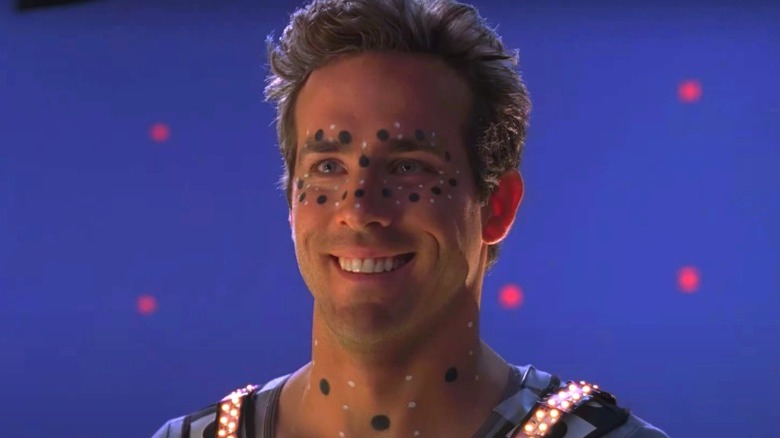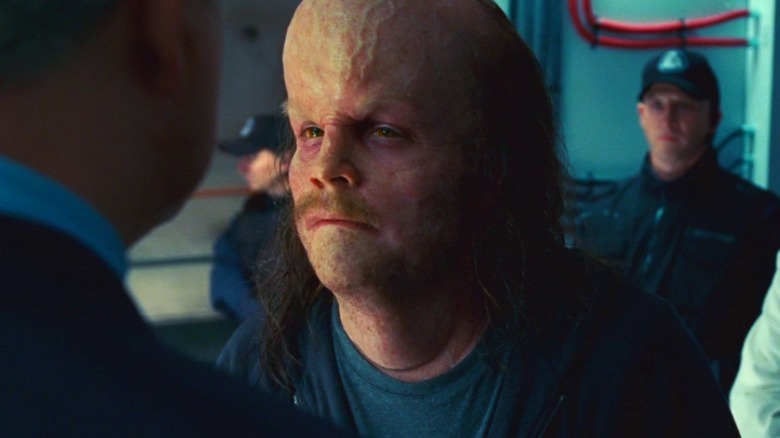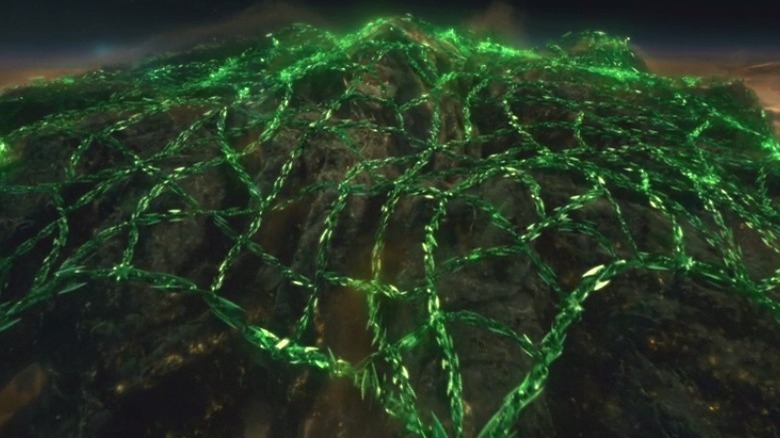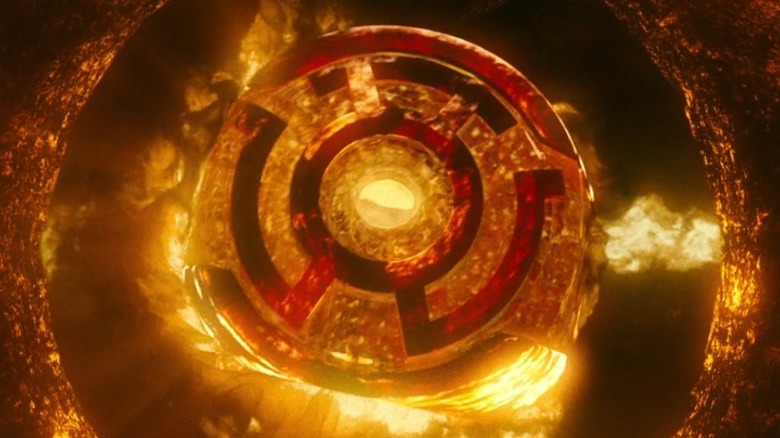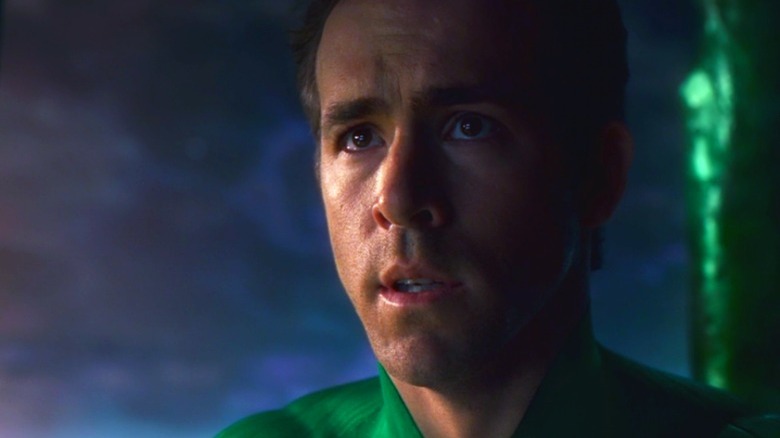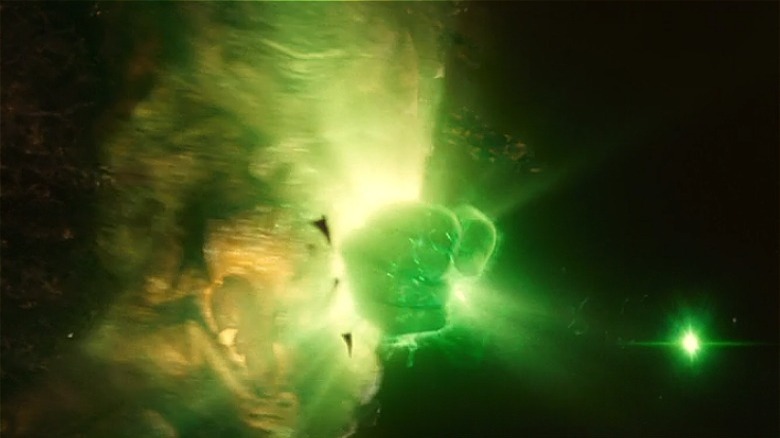Things In Green Lantern That Make No Sense
Three years into the Marvel Cinematic Universe's Phase 1, a year before Nolan's "The Dark Knight Rises," and two years before the launch of the Snyderverse with "Man of Steel," another DC Comics character blasted his way to the big screen, "Green Lantern." The Ryan Reynolds-starring film had the potential to launch a superhero franchise. But instead of soaring to intergalactic heights, it crash-landed. Reynolds discussed why he thought it failed with EW, stating, "Well, it's simple: Deadpool always knew what it was. With Green Lantern, I don't think anyone ever figured out exactly what it was — It also fell victim to the process in Hollywood, which is: poster first, release date second, and script last." Ten years after the film hit theaters, director Martin Campbell said, "Superhero movies are not my cup of tea, and for that reason, I shouldn't have done it."
With the movie's star and the director agreeing it was a bad idea, it's no wonder this movie had issues. Modern audiences are more discerning when it comes to blockbusters. They recognize when one soars like "Top Gun: Maverick." With Dwayne Johnson's upcoming "Black Adam" release this month, I thought it'd be fun to revisit why "Green Lantern" misfired and point out the moments in Hal Jordan's big-screen outing that make absolutely no sense. So buckle up, space cops! It's time to charge this movie with black hole-sized plot crimes.
Parallax's easy prison break
The intro voiceover (a.k.a. exposition dump) in "Green Lantern" tells audiences that the Green Lantern Corps' greatest enemy was an entity of fear called Parallax (Clancy Brown). Only the legendary Lantern Abin Sur (Temuera Morrison) could imprison him on the lost planet of Ryut. Three unnamed aliens crash on Ryut and fall through the surface to a giant cave, conveniently where Parallax is. He bellows: "You are afraid. Good." He then sucks the souls out of the aliens, breaks free of his glowing green shackles, and flies off to seek revenge on those who imprisoned him.
There are several head-scratching moments here. First, the ground crumbles like it's wet cardboard. If Abin Sur made such an extreme effort to hide Parallax, wouldn't he make sure the surface above could at least hold three human-sized lifeforms walking on it? Nope! Parallax becomes trapped in a green stone or glass — the film doesn't say — but whatever it is, it's not structurally sound. All it takes is the souls of these three unlucky space explorers, and the greatest threat to the cosmos can break out. Great work, Abin Sur! Maybe next time, reinforce the planet's exterior or toss this "lost planet" further away, so no one can stumble upon an unstoppable, giant fear monster.
Hal's tragic past
This next baffling moment in "Green Lantern" is only in its extended edition. In an 8-minute prologue cut out of the theatrical release, we see Hal (Gattlin Griffith) as a boy, Hector's (Kennon Kepper) seeds of jealousy, and the eventual romance between Hal and Carol (Jenna Craig). Hal's Dad, Martin (Jon Tenney), tests an aircraft that he hopes can break Mach 3. A large group gathers on the runway cheering — Hal included — as Martin takes off, only to have a malfunction cause an explosion. The aircraft crashes, so Hal runs to the wreckage. The plane explodes and kills his father.
In comic book lore, it's standard that superheroes experience the death of a parental figure at a young age. Clark Kent, Bruce Wayne, and Peter Parker have all gone through it. Usually, it's an emotionally resonating moment, but in "Green Lantern," there are far too many distracting and questionable details. Who are these random spectators? Why are they allowed to stand on the runway so close to a test launch? We get that it was the '80s — a time obsessed with "the race to space" — but that's still incredibly dangerous. Also, if Martin had any urgency to exit the plane crash, he would have survived. How did Hal not get injured being so close to an exploding plane? Guess shrapnel doesn't exist? Sadly, what's supposed to be a moving and tragic moment in "Green Lantern" elicits giggles.
Too many flashbacks
We don't want to harp on the added prologue in the extended edition of "Green Lantern" because had it been executed better, it could have been an excellent character-building intro for Hal, Carol, and Hector. Unfortunately, this effect becomes amplified when minutes later, we have to sit through several flashbacks and prologue beats again as Hal panics during his test flight.
Yes, this is a nitpicky issue to raise. Technically, the theatrical cut isn't guilty of this, and that release is the most widely known version. But the extended edition of "Green Lantern" exists. We see Hal's dad die in the prologue. A short time later, we see a flashback of Hal panicking while in freefall. There's no new perspective or added information, just recycled clips. This move feels like it underestimates the audience's intelligence. All we need is the shot of Hal looking at his dad's photo to know what he's thinking about and reliving. Showing the flashback we just saw feels like it's spoon-feeding the audience.
Hal is kind of a jerk!
Later in "Green Lantern," Hal (Ryan Reynolds) becomes a successful test pilot. He wakes up next to an unnamed woman and is late for an important day at work. He's supposed to show how the new drones perform against a human pilot. Already under the boss' skin for his tardiness, things don't improve. During the test sequence, he sacrifices his wingman Carol (now played by Blake Lively), breaks the rules of engagement, and crashes a multi-million dollar plane. He's fired, and several workers become laid off due to his actions.
Another superhero cliché is that our hero begins as an ego-driven show-off (see: Tony Stark) before being humbled to become a team player fighting for the greater good. Hal's first few scenes stretch Ryan Reynolds' likeability to its breaking point. He offers his sleepover guest "water in the tap." During his mock dogfight, he sacrifices his wingman under the guise of working together and tells Carol: "Just stay right there and look pretty." He can only defeat the drones by going above the approved ceiling, where the planes will stall, endangering himself and millions of dollars in equipment. He's not apologetic and still thinks he's right. His reckless actions get his fellow workers fired, and then he punches them across the parking lot with his new ring power when they confront him about it. Not cool, Hal!
Abin Sur's crash landing on Earth
In "Green Lantern," Abin Sur's ship crashes on the coast in broad daylight. He sends his ring out to choose the next Green Lantern. That night Hal is transported by the ring to the crash site. Abin Sur tells him he's been chosen to speak the oath. What oath? Hal if we know. Abin Sur dies, Hal's buddy shows up in his jeep, and they drive off just as government helicopters arrive.
A ship of unknown origin breaks through Earth's atmosphere and crashes in an area. Someone should have noticed! Then a green orb is sent from that site all around the city. Again no one sees this, and the purple alien takes a nap all day undisturbed. No cell phone, CCTV camera, or person sees Hal flying around the city via a giant green orb. He meets the alien and becomes consumed with grief for this dying stranger — then wonders at witnessing an extraterrestrial in the flesh. Tom (Taika Waititi) shows up, and they drive off as two helicopters approach. Why do these helicopters let Tom and Hal leave one of Earth's most significant discoveries of alien lifeforms without asking questions? We may never know.
Green Lantern's oath
After witnessing the alien's death, Hal returns to his apartment shaken and confused about being "chosen" for something he doesn't understand. He attempts to figure out the oath Abin Sur said he needs to speak. He tries out jokey bits like: "by the power of Greyskull," "to infinity and beyond," and "I, Hal Jordan, do solemnly swear to pledge allegiance to a lantern that I got from a dying alien in a swamp." After getting frustrated, Hal knocks the ring into the Lantern, which emits a glowing green light. Hal's eyes glow as he recites, "In brightest day, in blackest night..." (You know the rest.)
Abin Sur told Hal to speak the oath to unlock the ring's powers, but he neglected to share any other details. Will this plot device show Hal earning the ability to discover the pledge by some heroic unselfish act? Nope! Lucky for Hal, the Lantern he was given as a matching accessory somehow tells him what to say. All he has to do is touch the two together, and he immediately knows the sacred speech. A moment that could have been a way to make Hal prove he's worthy feels like a rushed story beat played for laughs instead of character development.
CGI green mask
After letting loose a giant green fist of fury against his angry co-workers, Hal travels through space to the Green Lantern home planet of OA. Here, he's put in an energy chamber where the ring unlocks his custom Lantern suit. To its credit, the suit is impressively comic book accurate. For the most part, it looks decent — except for the film's ridiculous CGI mask.
Digital Spy quotes Ryan Reynolds defending the mask (upon release, not after years of hindsight), saying: "It has to be virtual rather than spandex — This is a suit from an alien planet. The suit is powered specifically on his will, his emotion, his creativity, and his imagination." Sure, that all sounds great on paper.
In the movie, we're told the mask will appear when Hal's identity needs to be protected, so it makes sense for its quick disappearing act ability. But there must have been a way to do this with practical effects — or at least a mix of practical and CGI. As it stands, all of Reynolds' facial expressions in the film land (deeply) in the uncanny valley. Sadly, this choice takes the audience out of the film.
Hector's monstrous transformation
While examining the corpse of Abin Sur, Hector (Peter Sarsgaard) gets infected by stray particles left from Parallax's attack. He transforms from a nebbish scientist to a yellow-eyed telekinetic rage-filled being — eventually becoming hideously disfigured, and his humanity is a distant echo. Parallax feeds on his jealousy, turning him into a monster.
How does this spec of Parallax infect Hector? We're guessing because it's part of Parallax, it has some sentience, and that's how he establishes a psychic connection with Hector galaxies away. Okay, that falls under standard comic book movie logic guidelines. However, what is Hector transforming into? Why does this only happen to Hector? If Abin Sur had this parasitic goo inside his body, why did he die and not transform too? If Parallax could possess people with a spec of his essence, wouldn't Abin Sur have been a better candidate? Hector's hideous form seems to be solely for a creepy effect. We never know what the end goal is for him. He's killed off by Parallax as soon as the creature arrives on Earth, so I guess we'll have to wait for the sequel to get more answers... oh, shoot, never mind!
Twelve Lanterns vs. Parallax
Sinestro (Mark Strong) gives a rousing speech to thousands of Green Lanterns on OA about Parallax's threat: They must stop him, or their worlds will fall. He then takes 11 of his best Lanterns to confront this mighty foe. The Lanterns create a giant cosmic net around Parallax and shoot energy blasts at him. But Parallax quickly breaks these bonds and consumes the Lanterns' souls — except Sinestro, who watches helplessly.
If Parallax is so unstoppable, why do they only take a dozen Lanterns and not a least a few hundred? We get that each Lantern is in charge of their own space sector, but Parallax threatens the entire known universe. Maybe a few could play hooky with their current patrol duties? The attack seemed poorly planned, with the Lanterns dispatched within seconds. Also, how did Sinestro manage to escape? Was Parallax sluggish after his mini-buffet of yummy Lantern souls? Or was it just because the script needed someone to survive to deliver exposition to the Guardians and OA?
Gullible Guardians
The Guardians sit above the Lanterns in OA, guiding and planning their actions across millennia. They tell Sinestro that Parallax was one of them. But he was corrupted by using the power of fear over will. They warn such a mistake shall never happen again. Then Sinestro suggests to the council that the only solution is to "fight fear with fear." The Guardians throw all caution to the wind and immediately agree to forge a new ring that harnesses this unstable power. Uh-oh!
There are so many illogical details to unpack here. First, why haven't the Guardians done anything to stop Parallax? Why didn't they reveal his origin to Sinestro before he led his now-dead eleven Lanterns into battle? The Guardians know that fear caused the creation of Parallax in the first place. Why would they want to risk using this power again and potentially corrupt Sinestro, a man whose name is basically "Sinister" and oozes evil? They seem gullible or just horrible at their one job: guarding the universe.
Hal's plead to the guardians of OA
Green Lantern goes to OA to plead with the Guardians and Sinestro to save his world. He gives an impassioned speech about how humans "aren't the strongest species or the smartest." He continues: We're young, we have a lot to learn, but we're worth saving." He tells the Guardians that they're "afraid to admit they're afraid." However, they say still say no, leaving him to ask permission to save his planet.
The Guardians are really terrible at their job! They just lost eleven Lanterns, decided to make another weapon that caused all their problems in the first place, and then refused to help stop the monster that will 100% come for them next once he's done with Earth. On top of that, Hal goes to them for help and doesn't get it. Why does he need permission to save his planet? It's not like they stripped him of his Lantern powers and he needs them back. Maybe this entire scene exists so Sinestro can show up in a deus ex machina moment and save Hal?
One punch defeats Parallax
In the film's final act, Parallax and Green Lantern have a cosmically charged showdown on Earth. But before Parallax can endanger too many people, Hal leads him into space. He then flies dangerously close to the sun because, as Hal says, "the bigger you are, the faster you burn." Hal creates two F-35s to hold him back from the sun's gravitational pull and then delivers a giant green knuckle sandwich to Parallax's face — sending him into the sun, where he burns to bits.
Parallax is considered a nearly unstoppable force, a dangerous pitfall to create in a movie. Inevitably, the filmmakers have to find some way to kill the bad guy. But no one watching this movie would expect one punch would do it. Expert Lanterns couldn't make a dent in Parallax, but one strike from a rookie does the trick? Parallax should have easily recovered from a single punch and quickly flown out of the gravity undertow he was in, but instead, he sinks and burns. Sadly, it's anti-climactic. The callback to Hal using F-35s to save the day in a new way is fun. However, there could have been a bigger payoff than a punch to the kisser to end this Big Bad's reign of terror.
